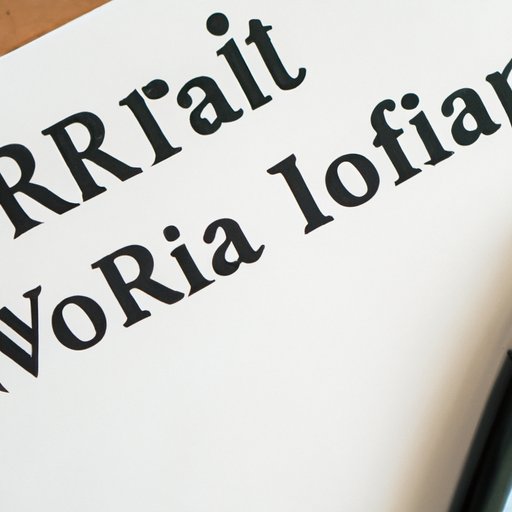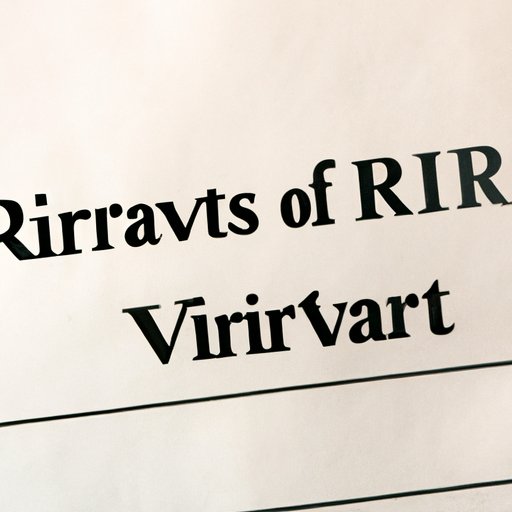
I. Introduction
Roth Individual Retirement Accounts (IRAs) are one of the most popular retirement savings accounts in America. They offer tax-free growth and withdrawals, making them a great tool for retirement planning. However, many people may wonder – can I take money out of my Roth IRA without any penalties or consequences? In this article, we will explore the rules, benefits, and drawbacks of Roth IRA withdrawals, as well as alternative options for accessing funds in case of emergencies.
II. Roth IRA Withdrawals: The Basics
Roth IRAs are funded with post-tax income, meaning that you won’t get a tax deduction for the contributions made to them. However, once you reach age 59 ½, you can withdraw both contributions and earnings tax-free. Additionally, Roth IRAs are not subject to required minimum distributions (RMDs) during the lifetime of the original owner, allowing for flexibility and control over retirement savings.
A. Contribution rules
For 2021, the contribution limit for those under 50 years old is $6,000, and those 50 and older can contribute up to $7,000 per year. However, your ability to contribute to a Roth IRA is limited by your income. For single filers, the ability to contribute starts to phase out at $125,000 and ends at $140,000. For married couples filing jointly, the phase-out begins at $198,000 and ends at $208,000.
B. Withdrawal rules
When it comes to withdrawals, the first step is to determine whether the distribution is qualified or non-qualified. Qualified distributions are tax-free and penalty-free, and occur after the account owner has had the account for at least five years, and either reached age 59 ½, become disabled, or passed away. Non-qualified distributions, on the other hand, may be subject to taxes and penalties, depending on the circumstances.
C. Penalties for early withdrawals
If you take a non-qualified withdrawal before you reach age 59 ½, you may be subject to a 10% early withdrawal penalty. The penalty is also applicable to the earnings portion of the withdrawal. There are, however, some exceptions that allow you to withdraw funds penalty-free, discussed in the section below.
D. Impact on retirement savings goals
It’s important to keep in mind that taking money out of your Roth IRA means potentially sacrificing future growth and retirement income. Therefore, it’s essential to weigh the trade-offs between the need for immediate funds and the potential long-term consequences on your retirement goals.
III. When It Makes Sense to Withdraw from a Roth IRA
While it’s generally recommended to keep your retirement savings accounted for and untouched, there are some situations where it may make sense to withdraw funds from your Roth IRA:
A. Major medical expenses
If you have significant medical expenses that are not fully covered by insurance, you may need to withdraw funds to cover the costs. In some cases, you may be able to withdraw funds penalty-free if the medical expenses exceed 10% of your adjusted gross income (AGI).
B. Home purchase
You may use up to $10,000 in Roth IRA funds to fund a home purchase. The distribution must be used within 120 days of withdrawal to qualify for this exception. However, keep in mind that this may deplete your retirement savings and impact your long-term goals.
C. Unexpected emergencies
Emergencies like job loss, prolonged medical illness, or a natural disaster may require immediate access to cash. In such cases, you may consider withdrawing funds from your Roth IRA as a last resort. However, remember that withdrawals from your Roth account may impact future growth and retirement income.
D. Higher education expenses
You may use Roth IRA funds to cover higher education expenses for yourself, your spouse, or children or grandchildren. This includes tuition, books, and supplies for qualifying schools. The distribution must be used for qualified expenses to avoid taxes and penalties.
E. Debt management
High-interest debt like credit card balances or medical bills can accrue quickly, and it may make sense to use Roth IRA funds to pay off the debt. However, keep in mind the potential impact on your retirement savings and future growth.
IV. Pros and Cons of Taking Money Out of a Roth IRA
Before withdrawing money from a Roth IRA, it’s essential to weigh the potential pros and cons:
A. Benefits of withdrawing
- Access to immediate funds in case of emergencies or unforeseen expenses
- Option to avoid penalties under the certain exceptions
- Ability to use funds for certain qualified expenses without taxes or penalties
B. Drawbacks of withdrawing
- Potentially sacrificing long-term growth and retirement savings by reducing principal invested
- Possible impact on future retirement income goals
- Potential tax implications and penalties for non-qualified distributions
C. How to weigh the potential consequences
When considering whether to withdraw from a Roth IRA, it’s essential to consider the potential long-term consequences of your decision. Some factors to keep in mind include your current age, projected retirement income needs, and other sources of cash reserves. Additionally, it may be helpful to consult with a financial advisor or tax professional to determine the most beneficial course of action.

V. Withdrawing from a Roth IRA in Retirement
Once you reach retirement age, accessing your Roth IRA funds may become more critical. Here are some key factors to consider:
A. Tax implications
While qualified Roth IRA withdrawals are tax-free, non-qualifying distributions may be subject to taxes and should be factored into a retiree’s tax planning strategy.
B. Required minimum distributions
While Roth IRAs do not have RMDs during the lifetime of the original owner, beneficiaries who inherit the account are required to take distributions based on their own life expectancy under current law. Therefore, it’s essential to factor in any heirs or beneficiaries when planning for your retirement income needs.
C. Ensuring retirement income longevity
Withdrawal strategies should factor in longevity and sustainability of retirement income. Tools like annual budgets, safe withdrawal rates, and diversified tax planning can help retirees avoid running out of money during their retirement years.
VI. Common Questions and Answers about Roth IRA Withdrawals
A. How much can I take out each year?
While there is no limit to how much you can withdraw annually, it’s essential to keep in mind that withdrawals can impact future growth and retirement income goals.
B. How to avoid penalties for early withdrawals?
You can avoid penalties for early withdrawals by meeting certain exceptions, including medical expenses over 10% of your AGI, first-time homebuyers use, qualified higher education expenses, and certain types of reservist withdrawals. Consult with a tax professional to determine which exceptions may apply to your situation.
C. Can I put the money back into my Roth IRA?
While Roth IRA contributions have strict yearly limits, there is no limit on how many times you can re-contribute funds that you have taken out. However, remember that withdrawing funds will impact future retirement income growth, so it’s important to weigh the decision carefully.
VII. Alternatives to Withdrawing from a Roth IRA
If you need access to cash but want to avoid withdrawing from your Roth IRA, there are a few alternatives to consider:
A. Taking out a loan
Getting a loan from a bank or other financial institution may be a better option than withdrawing from a retirement account if you have regular income but lack temporary access to ready cash.
B. Tapping into a home equity line of credit
Homeowners who have built up equity in their homes may qualify for a home equity line of credit (HELOC) that allows them to borrow against that equity. Interest rates may be lower than other loan options, and interest payments may be tax-deductible. However, keep in mind that tapping into home equity can impact future financial planning and your ability to sell your property in the future.
C. Leveraging other assets
If you have other assets like investment funds or stocks, you may consider selling them for cash before withdrawing from a Roth IRA. However, keep in mind that selling other investments may impact future growth or result in capital gains taxes.
VIII. Conclusion
While Roth IRAs offer the flexibility and tax-free benefits, it’s essential to understand the rules and consequences of withdrawing funds. Before making any decisions about taking money out of your Roth IRA, it’s essential to weigh the trade-offs between your immediate and future financial needs, and factor in any potential tax or penalty implications.
Ultimately, it is always recommended to consult with a financial or tax professional to understand how a Roth IRA fits into your overall retirement savings strategy.





